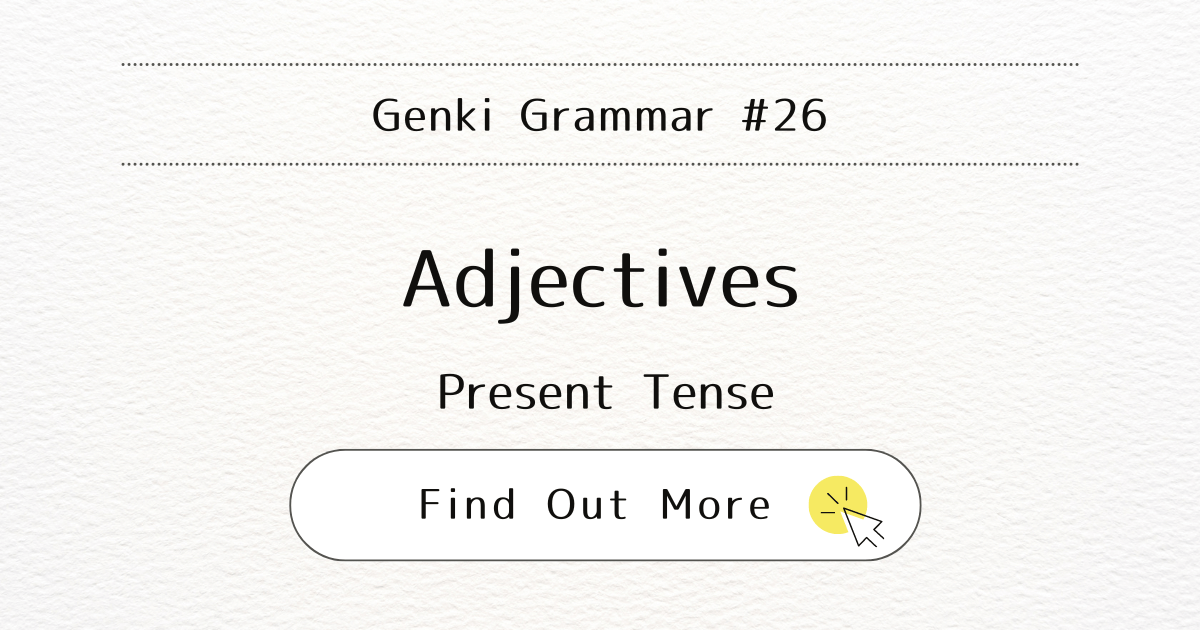
Introduction
In Japanese, there are two types of adjectives: い-adjectives (i-keiyoushi) and な-adjectives (na-keiyoushi). This guide will help you master their present tense forms.
What It Means
Adjectives in Japanese change their form just like verbs. They change depending on whether you are talking about the present/future or past and whether you are saying something positive or negative. Understanding how to use these forms will help you speak and write more naturally.
When You Use It
Use the present tense of adjectives when you want to describe something happening now or something that is always true. This can be for current conditions or permanent characteristics of something.
Examples
い-Adjectives
For い-adjectives, you add です to the adjective for the affirmative form. For the negative form, you replace the last い with くないです.
| Affirmative | Negative |
| さむいです (samui desu) It is cold. | さむくないです (samukunai desu) It is not cold. |
Example :

その雑誌はおもしろいですか。
(Sono zasshi wa omoshiroi desu ka?)
Is that magazine interesting?

いいえ、あまりおもしろくないです。
(Iie, amari omoshirokunai desu.)
No, it is not very interesting.
な-Adjectives
For な-adjectives, you add です to the adjective for the affirmative form. For the negative form, you replace です with じゃないです.
| Affirmative | Negative |
| げんきです (genki desu) I am healthy. | げんきじゃないです (genki janai desu) I am not healthy. |
Example :

あした、ひまですか。 (Ashita, hima desu ka?)
Are you free tomorrow?

いいえ、ひまじゃないです。 (Iie, hima janai desu.)
No, I’m not.
Note
Both い- and な-adjectives have two negative forms: ないです (naidesu) and ありません (arimasen). ないです is more casual, while ありません is more formal and used in writing.
For い-adjectives, do not use the pattern for な-adjectives. For example, saying さむいじゃないです (samui janai desu) is incorrect.
Irregular Adjective: いい (ii) – Good
The adjective いい (ii) changes to よ (yo) in its negative form.
| Affirmative | Negative |
| いいです (ii desu) It is good. | よくないです (yokunai desu) It is not good. |
Example:

あの映画はいいですか。 (Ano eiga wa ii desu ka?)
Is that movie good?

いいえ、よくないです。 (Iie, yokunai desu.)
No, it is not good.
Special Case: かっこいい (kakkoii) – Cool
The adjective かっこいい (kakkoii) is a compound adjective that also follows the irregular pattern of いい (ii). It changes to かっこよくないです (kakkoyokunai desu) in its negative form.
Example:

あの車はかっこいいですか。 (Ano kuruma wa kakkoii desu ka?)
Is that car cool?

いいえ、かっこよくないです。 (Iie, kakkoyokunai desu.)
No, it is not cool.
Special Note: かわいい (kawaii) – Cute
Unlike かっこいい (kakkoii), the adjective かわいい (kawaii) does not change to よ (yo) in its negative form because it is not a compound adjective with いい (ii).
| Affirmative | Negative |
| かわいいです (kawaii desu) It is cute. | かわいくないです (kawaikunai desu) It is not cute. |

その犬はかわいいですか。 (Sono inu wa kawaii desu ka?)
Is that dog cute?

いいえ、かわいくないです。 (Iie, kawaikunai desu.)
No, it is not cute.
Conclusion
Mastering adjectives in the present tense is a crucial step in learning Japanese. Remember the different patterns for い-adjectives and な-adjectives, and be mindful of irregular adjectives like いい and special cases like かっこいい.



